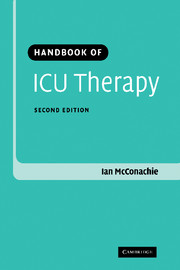Book contents
- Frontmatter
- Contents
- List of contributors
- Preface
- Part I Basic principles
- Part II Specific problems
- 17 The surgical patient in the ICU
- 18 The trauma patient
- 19 Acute coronary syndromes
- 20 Heart failure
- 21 Arrhythmias
- 22 The patient with sepsis
- 23 Acute renal failure in the critically ill
- 24 Acute lung injury and ARDS
- 25 The patient with gastrointestinal problems
- 26 The comatose patient
- 27 The critically ill asthmatic
- 28 The critically ill diabetic
- 29 The cardiac surgical patient in the ICU
- 30 Cardiac arrest
- Index
30 - Cardiac arrest
Published online by Cambridge University Press: 24 August 2009
- Frontmatter
- Contents
- List of contributors
- Preface
- Part I Basic principles
- Part II Specific problems
- 17 The surgical patient in the ICU
- 18 The trauma patient
- 19 Acute coronary syndromes
- 20 Heart failure
- 21 Arrhythmias
- 22 The patient with sepsis
- 23 Acute renal failure in the critically ill
- 24 Acute lung injury and ARDS
- 25 The patient with gastrointestinal problems
- 26 The comatose patient
- 27 The critically ill asthmatic
- 28 The critically ill diabetic
- 29 The cardiac surgical patient in the ICU
- 30 Cardiac arrest
- Index
Summary
Cardiac arrest is cessation of effective circulation due to asystole, ventricular fibrillation (VF) or pulseless electrical activity (PEA, previously known as electromechanical dissociation EMD).
Brain damage will occur within 4–6 min (unless protected by hypothermia). Therefore this is the ultimate cardiac emergency.
One of the truly landmark papers in the 20th century was that on closed chest cardiac resuscitation in 1960 by Kouwenhoven.
This was the start of the modern concept of cardiopulmonary resuscitation (CPR).
This chapter will briefly review current guidelines for basic life support (BLS) and advanced life support (ALS) and discuss some of the controversies in resuscitation research. The practical aspects of BLS and ALS are not covered in detail as these are best learnt at formal resuscitation courses.
All hospital doctors should be proficient at CPR and should receive regular training/practice at BLS and ALS.
Causes
Asystole is the first diagnosed rhythm in approximately 30% of cardiac arrest victims. In some, especially out-of-hospital arrests this will be due to untreated VF (especially if bystander CPR has not been initiated). In hospital, asystole may be due to severe coronary artery disease and myocardial infarction (MI). Occasionally hypoxia and other acute, severe medical conditions may result in asystolic arrest. Rarely asystole may be due to excess vagal stimulation or carotid sinus hypersensitivity.
[…]
- Type
- Chapter
- Information
- Handbook of ICU Therapy , pp. 416 - 428Publisher: Cambridge University PressPrint publication year: 2006

